
Prostanthera incisa, commonly known as cut-leaf mint-bush or native thyme, is a species of flowering plant in the family Lamiaceae and is endemic to south-eastern continental Australia. It is an erect, strongly aromatic, openly branched shrub with hairy, densely glandular branches, egg-shaped to oblong leaves, and pale mauve to mauve flowers.

Prostanthera ovalifolia, commonly known as the oval-leaf mintbush or purple mintbush, is a species of flowering plant in the family Lamiaceae and is endemic to south-eastern continental Australia. It is an erect shrub with egg-shaped leaves and groups of mauve to deep blue-purple flowers arranged in groups at the ends of branchlets.

Prostanthera nivea, commonly known as snowy mint-bush, is a species of flowering plant in the family Lamiaceae and is endemic to eastern Australia. It is a shrub with linear to cylindrical leaves and white flowers arranged in leaf axils near the ends of branchlets and is one of the mint-bushes that is not aromatic.

Prostanthera cryptandroides is a species of flowering plant in the family Lamiaceae and is endemic to eastern Australia. It is a low, spreading shrub with narrow egg-shaped leaves and lilac to mauve flowers arranged singly in leaf axils.

Prostanthera stenophylla is a species of flowering plant in the family Lamiaceae and is endemic to Wollemi National Park in New South Wales. It is an erect, slender, aromatic shrub with hairy, oblong leaves and small groups of pale bluish mauve to violet flowers.

Prostanthera linearis, commonly known as narrow-leaved mint-bush is a species of flowering plant in the family Lamiaceae and is endemic to eastern Australia. It is an erect, faintly aromatic shrub with glabrous, narrow egg-shaped to linear leaves and white flowers that are often tinged with pinkish-mauve.
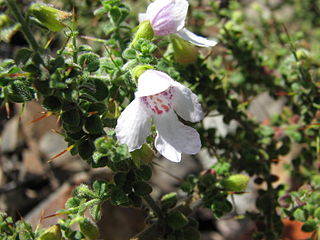
Prostanthera arapilensis is a flowering plant in the family Lamiaceae and is endemic to a small area of Victoria, Australia. It is an erect shrub with hairy branches, broadly egg-shaped to more or less round leaves and pale mauve or white flowers with orange-brown spots or streaks inside the petal tube.
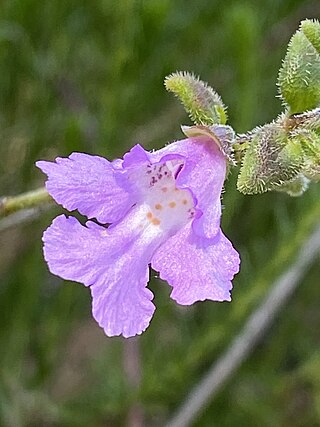
Prostanthera marifolia, commonly known as Seaforth mintbush, is a species of flowering plant that is endemic to a restricted area of New South Wales. It is a small, erect, openly branched shrub with egg-shaped to elliptic leaves, and purple to mauve flowers arranged in leaf axils.

Prostanthera rhombea, commonly known as sparkling mint-bush, is a plant in the family Lamiaceae and is endemic to disjunct areas of south-eastern Australia. It is an openly-branched shrub with strongly aromatic branches, circular to heart-shaped leaves and mauve or bluish flowers.

Prostanthera denticulata, commonly known as rough mint-bush, is a species of flowering plant in the family Lamiaceae and is endemic to coastal New South Wales. It is a straggling to almost prostrate, aromatic shrub with narrow egg-shaped leaves and purple to mauve flowers arranged in leaf axils or on the ends of branchlets.
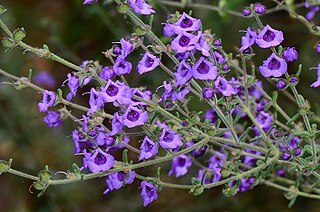
Prostanthera hirtula, commonly known as hairy mintbush, is a species of flowering plant in the family Lamiaceae and is endemic to the south-eastern continental Australia. It is a strongly aromatic, densely hairy, spreading shrub with narrow egg-shaped leaves and dark mauve flowers, and that grows in exposed, rocky sites.

Prostanthera cineolifera, commonly known as the Singleton mint bush, is a species of flowering plant in the family Lamiaceae and is endemic to eastern New South Wales. It is an erect shrub with hairy branches, narrow egg-shaped leaves and clusters of pale mauve to dark purple-mauve flowers arranged on the ends of branchlets.
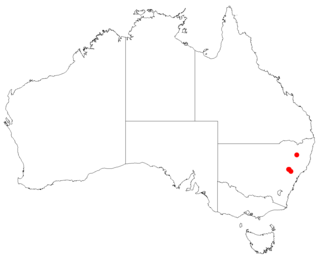
Prostanthera discolor is a species of flowering plant in the family Lamiaceae and is endemic to a small area of New South Wales. It is an open, erect, strongly aromatic shrub with lance-shaped to oblong leaves, and deep mauve to purple flowers with darker spots inside.
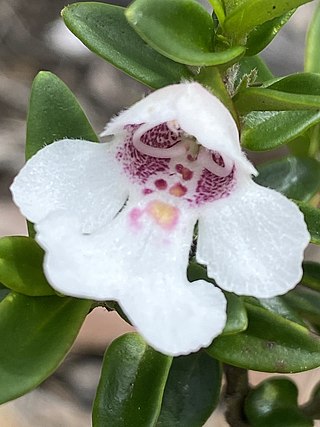
Prostanthera gilesii is a species of flowering plant in the family Lamiaceae and is endemic to the Mount Canobolas area of New South Wales. It is a small, compact, spreading shrub with aromatic, narrow egg-shaped to elliptical leaves, and white to yellowish white flowers with purple to dark mauve markings inside the petal tube and pale orange markings on the petal lobes.

Prostanthera hindii is a species of flowering plant in the family Lamiaceae and is endemic to the Central Tablelands of New South Wales. It is a small, erect shrub with densely hairy branches, egg-shaped leaves, and mauve flowers with deep mauve to dark purple colouration inside the petal tube.

Prostanthera lanceolata is a species of flowering plant in the family Lamiaceae and is endemic to near-coastal area of eastern Australia. It is an erect, aromatic shrub that has stems that are square in cross-section, glandular, egg-shaped leaves and mauve or deep bluish-purple flowers.

Prostanthera oleoides is a species of flowering plant that is endemic to central Queensland. It is an open, erect shrub with four-sided branchlets, narrow elliptic, oblong or egg-shaped leaves with the narrower end towards the base, and mauve flowers with purple to dark mauve markings.

Prostanthera ringens, commonly known as gaping mint-bush, is a species of flowering plant in the family Lamiaceae and is endemic to eastern Australia. It is a bushy shrub with four-sided, hairy, densely glandular branches, oblong or egg-shaped leaves and pale blue to greenish or yellow flowers arranged singly in leaf axils.
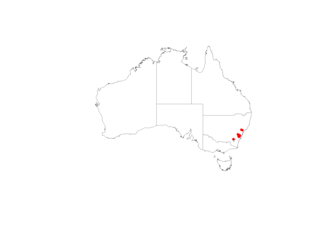
Prostanthera rugosa is a species of flowering plant in the family Lamiaceae and is endemic to a restricted area of New South Wales. It is an openly-branched shrub with egg-shaped or narrow egg-shaped, thick, fleshy leaves and mauve flowers with a white tinge arranged in leaf axils near the ends of branchlets.

Prostanthera violacea, commonly known as violet mint-bush, is a species of flowering plant in the family Lamiaceae and is endemic to south-eastern New South Wales. It is a slender, strongly aromatic shrub with densely hairy branches, more or less round leaves with the edges rolled under and mauve to bluish flowers often with white tips.























